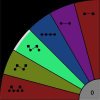Stable individual characteristics in the perception of multiple embedded patterns in multistable auditory stimuli
- PMID: 24616656
- PMCID: PMC3937586
- DOI: 10.3389/fnins.2014.00025
Stable individual characteristics in the perception of multiple embedded patterns in multistable auditory stimuli
Abstract
The ability of the auditory system to parse complex scenes into component objects in order to extract information from the environment is very robust, yet the processing principles underlying this ability are still not well understood. This study was designed to investigate the proposal that the auditory system constructs multiple interpretations of the acoustic scene in parallel, based on the finding that when listening to a long repetitive sequence listeners report switching between different perceptual organizations. Using the "ABA-" auditory streaming paradigm we trained listeners until they could reliably recognize all possible embedded patterns of length four which could in principle be extracted from the sequence, and in a series of test sessions investigated their spontaneous reports of those patterns. With the training allowing them to identify and mark a wider variety of possible patterns, participants spontaneously reported many more patterns than the ones traditionally assumed (Integrated vs. Segregated). Despite receiving consistent training and despite the apparent randomness of perceptual switching, we found individual switching patterns were idiosyncratic; i.e., the perceptual switching patterns of each participant were more similar to their own switching patterns in different sessions than to those of other participants. These individual differences were found to be preserved even between test sessions held a year after the initial experiment. Our results support the idea that the auditory system attempts to extract an exhaustive set of embedded patterns which can be used to generate expectations of future events and which by competing for dominance give rise to (changing) perceptual awareness, with the characteristics of pattern discovery and perceptual competition having a strong idiosyncratic component. Perceptual multistability thus provides a means for characterizing both general mechanisms and individual differences in human perception.
Keywords: auditory scene analysis; auditory streaming; individual differences; multistability; perceptual switching.
Figures












References
-
- Anstis S., Saida S. (1985). Adaptation to auditory streaming of frequency-modulated tones. J. Exp. Psychol. Hum. Percept. Perform. 11, 257–271 10.1037/0096-1523.11.3.257 - DOI
-
- Bendixen A., Bõhm T. M., Szalárdy O., Mill R., Denham S. L., Winkler I. (2013). Different roles of similarity and predictability in auditory stream segregation. Learn. Percept. 2, 37–54 10.1556/LP.5.2013.Suppl2.4 - DOI
LinkOut - more resources
Full Text Sources
Other Literature Sources

